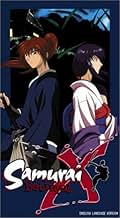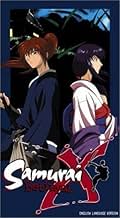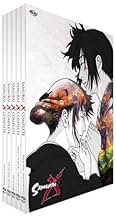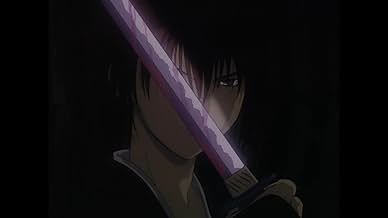Rurouni Kenshin: Trust and Betrayal
Original title: Rurôni Kenshin: Meiji kenkaku romantan - Tsuioku-hen
IMDb RATING
8.6/10
17K
YOUR RATING
In the era of Japan's Meiji Restoration, an assassin regains his humanity.In the era of Japan's Meiji Restoration, an assassin regains his humanity.In the era of Japan's Meiji Restoration, an assassin regains his humanity.
Browse episodes
Storyline
Did you know
- TriviaAlthough the of Kenshin's life depicted in this OVA series was also detailed in the original manga, the TV series "Rurouni Kenshin: Meiji kenkaku roman tan" (1996) never mentions Tomoe by name, but Hiko does mention ask Kenshin about his lost love at Tomoe's gravesite in Kyoto. The only characters aside from Kenshin that also appear in the TV series are Saito, Hiko, and assumedly Shishio (the unnamed assassin).
- Crazy creditsThe original DVDs from ADV Films replaced the original Japanese title card to read: 'Samurai X: Trust' and 'Samurai X: Betrayal'. This is restored for the Director's Cut DVD.
- Alternate versionsThe original DVDs from ADV Films feature the original 4 OVA episodes on two DVDs. These episodes were later combined into a Director's Cut DVD.
- ConnectionsFeatured in Anime Network Commercial 1 (2004)
- SoundtracksQuiet Life
by Taku Iwasaki
Featured review
Forget the famous Rurouni Kenshin TV series. This has nothing to do with it. Well, yes, it's supposed to be a prequel, but the tone, mood and depth of it makes it a completely different story. It's a lyric and very adult tale about love, death, politics and betrayal that deserved, not only a theatrical release, but also massive exposure.
Production values are extraordinary and it's packed with more expressive resources than all western animation ever. Look specially for one of the best representations of smell in the history of filmmaking.
But the best part is the story. Layer over layer of meaning and symbolism create a tight, dark and deep tale. Nothing is said, nothing is shown that doesn't bear deep significance, be it a cryptic sentence, a shot of a child's toy or a slash through the face.
And then there's the fights. When "Crouching Tiger, Hidden Dragon" opened everybody talked about how the fights revealed character. Well, Rurouni Kenshin does the same thing much better, and it doesn't need 10 minutes each time. The fights are short and brutal, swords actually cut the flesh, but there's so much being told each time.
One of the most beautiful things here is what's left off screen. Rurouni Kenshin is a historical epic, but history isn't shown directly to the viewer, it isn't spelled out for you. We focus on the characters. They go through history, sometimes they even change it, but we are not shown the politics and the fights for power. We stay with Kenshin, an assassin, a mere pawn in those fights. We see the killing and then we hear the vague echoes of what it causes. The story is moved forward, but we have to build it back together with the information we receive through Kenshin's eyes. Yes, this is what critics mean when they talk about a `demanding' film.
Rurouni Kenshin is a work of art. Well worth your time and money. It comes in two one-hour volumes (two chapters each), but the best way to experience it is seeing them all back to back, as a two hour feature film. Two thumbs up and go get it.
Production values are extraordinary and it's packed with more expressive resources than all western animation ever. Look specially for one of the best representations of smell in the history of filmmaking.
But the best part is the story. Layer over layer of meaning and symbolism create a tight, dark and deep tale. Nothing is said, nothing is shown that doesn't bear deep significance, be it a cryptic sentence, a shot of a child's toy or a slash through the face.
And then there's the fights. When "Crouching Tiger, Hidden Dragon" opened everybody talked about how the fights revealed character. Well, Rurouni Kenshin does the same thing much better, and it doesn't need 10 minutes each time. The fights are short and brutal, swords actually cut the flesh, but there's so much being told each time.
One of the most beautiful things here is what's left off screen. Rurouni Kenshin is a historical epic, but history isn't shown directly to the viewer, it isn't spelled out for you. We focus on the characters. They go through history, sometimes they even change it, but we are not shown the politics and the fights for power. We stay with Kenshin, an assassin, a mere pawn in those fights. We see the killing and then we hear the vague echoes of what it causes. The story is moved forward, but we have to build it back together with the information we receive through Kenshin's eyes. Yes, this is what critics mean when they talk about a `demanding' film.
Rurouni Kenshin is a work of art. Well worth your time and money. It comes in two one-hour volumes (two chapters each), but the best way to experience it is seeing them all back to back, as a two hour feature film. Two thumbs up and go get it.
- NestorForjan
- Nov 23, 2002
- Permalink
- How many seasons does Rurouni Kenshin: Trust and Betrayal have?Powered by Alexa
Details
- Release date
- Country of origin
- Language
- Also known as
- Rurouni Kenshin: Trust & Betrayal
- Production companies
- See more company credits at IMDbPro
- Runtime30 minutes
- Color
- Sound mix
- Aspect ratio
- 1.33 : 1
Contribute to this page
Suggest an edit or add missing content

Top Gap
What is the French language plot outline for Rurouni Kenshin: Trust and Betrayal (1999)?
Answer
































